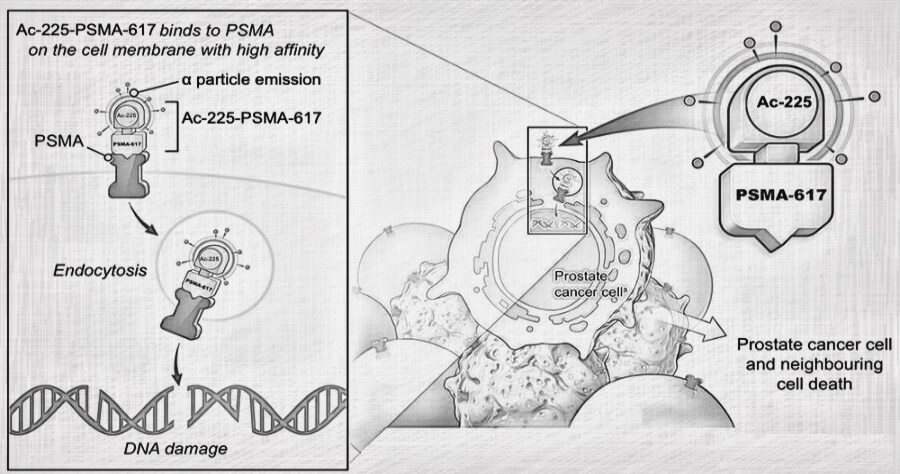Cancer. Just the word itself sends shivers down our spines. But what if there was a new weapon in the fight against this relentless disease? Enter actinium-225, a radioactive isotope emerging as a promising star in the world of radiation therapy.
Why Actinium-225? Here’s the Lowdown
Traditional radiation therapy uses beams of high-energy radiation to zap cancer cells. While effective, it can also damage healthy tissues nearby. Actinium-225 offers a more targeted approach. This “radioactive hero” is like a tiny assassin sent straight to the enemy’s camp (cancer cells). Here’s why it’s gaining ground:
Alpha Power: Unlike traditional radiation, actinium-225 fires alpha particles. Imagine alpha particles as tiny, super-charged bullets with a very short travel distance. This means they deliver a powerful punch directly to cancer cells, minimizing damage to surrounding healthy tissue.
Targeted Delivery: Actinium-225 doesn’t go rogue. Scientists can attach it to molecules that act like beacons, attracting them to specific receptors on cancer cells. This ensures the radioactive attack only happens where it’s needed.
Types of Actinium-225 Treatments
While research is ongoing, actinium-225 shows promise in treating various cancers, particularly those resistant to conventional therapies. Here are a few examples:
Prostate Cancer: Actinium-225, often paired with molecules that target the prostate-specific membrane antigen (PSMA), has shown significant results in shrinking and potentially eliminating late-stage prostate cancer.
Leukemia: Early trials suggest actinium-225’s targeted attack could be effective in fighting certain types of leukemia.
Other Cancers: Researchers are exploring the potential of actinium-225 in treating other aggressive cancers like melanoma and brain tumors.
Benefits of Actinium-225 Treatment
While still under investigation, actinium-225 offers some potential advantages over traditional radiation therapy:
Reduced Side Effects: Thanks to the targeted nature of alpha particles, actinium-225 treatment may cause fewer side effects like fatigue, nausea, and hair loss compared to standard radiation.
Potentially More Effective: Early studies suggest actinium-225 might be more effective in shrinking tumors, especially in cases where traditional treatments haven’t worked.
How Does Actinium-225 Treatment Work?
Here’s a simplified breakdown of the process:
Preparation: Doctors will assess your individual case and determine if actinium-225 treatment is suitable.
Creating the Weapon: Scientists prepare the actinium-225 isotope and attach it to the targeting molecule.
Delivery: The actinium-225 payload is typically injected into your bloodstream.
Seeking and Destroying: The targeting molecule guides the actinium-225 straight to the cancer cells.
Alpha Strike: The actinium-225 within the cancer cells releases alpha particles, causing DNA damage and ultimately killing the cancer cells.
Conclusion
Actinium-225 treatment is a promising new frontier in targeted radiation therapy. While more research is needed to determine its long-term efficacy and wider applicability, it offers a ray of hope for cancer patients, particularly those whose battles have been grueling with limited options.
FAQs
Is actinium-225 treatment widely available?
Currently, actinium-225 treatment is still in the clinical trial phase. Availability may be limited depending on your location and specific type of cancer.
Are there side effects to actinium-225 treatment?
As with any treatment, there can be side effects. These are typically mild to moderate and may include fatigue, nausea, and low blood cell counts. Your doctor will discuss potential side effects in detail.
Is actinium-225 treatment covered by insurance?
Insurance coverage for actinium-225 treatment will vary depending on your specific plan and the stage of development of the treatment.
Remember: This information is for educational purposes only and shouldn’t be a substitute for professional medical advice. Always consult with your doctor to determine the best course of treatment for your individual situation.
